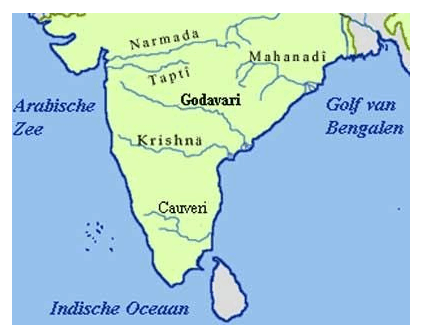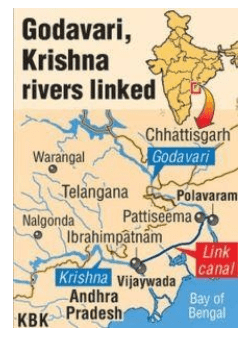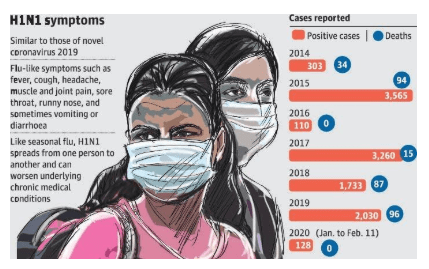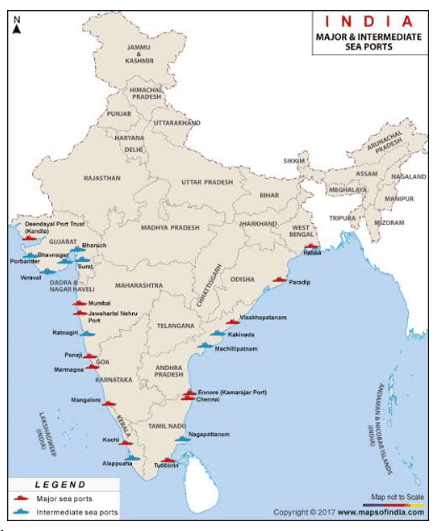IASbaba's Daily Current Affairs Analysis
IAS UPSC Prelims and Mains Exam – 13th February 2020
Archives
(PRELIMS + MAINS FOCUS)
Mana Krishna
In news:
- The Krishna district administration has launched ‘Mana Krishna’ (Our Krishna), a massive campaign of cleaning Krishna River canals as part of the Clean Krishna-Godavari Canals mission
- In the Krishna River and Godavari River basins in Andhra Pradesh.
- The site is known for the D-6 block where Reliance Industries discovered the biggest natural gas reserves in India in 2003
- The basin is home to olive ridley sea turtle, a vulnerable species

Daily Current Affairs IAS | UPSC Prelims and Mains Exam – 13th February 2020

Daily Current Affairs IAS | UPSC Prelims and Mains Exam – 13th February 2020
Industrial production shrinks 0.3% in December
In news:
- The Index of Industrial Production (IIP) had grown by 2.5% in December 2018.
- India’s industrial production growth turned negative in December, contracting by 0.3%, mainly on account of a decline in manufacturing sector output
- According to the National Statistical Office (NSO) data, the manufacturing sector output contracted by 1.2% in December 2019 as against a growth 2.9%
From Prelims Point of View:
Index of Industrial Production
- Growth rates in different industry groups of the economy in a fixed period of time.
- It is compiled and published monthly by the Central Statistical Organization (CSO), Ministry of Statistics and Programme Implementation.
Composite indicator rate of industry groups classified under:
- Broad sectors, namely, Mining, Manufacturing, and Electricity.
- Use-based sectors, namely Basic Goods, Capital Goods, and Intermediate Goods.
Core industries of India represent about 40% of the weight of items that are included in the IIP.
Significance of IIP :
- IIP is the only measure on the physical volume of production.
- It is used by government agencies including the Ministry of Finance, the Reserve Bank of India, etc, for policy-making purposes.
- IIP remains extremely relevant for the calculation of the quarterly and advance GDP estimates.
Coronavirus samples from Karnataka test positive for H1N1
In news:
- Suspected coronavirus (nCoV) cases that tested negative for the virus have tested positive for H1N1
- Although the novel coronavirus is related to Severe Acute Respiratory Syndrome (SARS), the only difference is that the efficiency of person to person transmission is high in the novel coronavirus

Daily Current Affairs IAS | UPSC Prelims and Mains Exam – 13th February 2020
From Prelims Point of View:
Coronaviruses
- Common in various species of animals, such as cattle, camels, bats, and cats.
- Cause diseases ranging from cold to SARS.
- Coronaviruses can infect humans, which can then spread from person to person.
- Coronaviruses cause respiratory infections in humans which are generally mild, but sometimes, can be fatal.
- Physically large as far as viruses go (26 – 32 kilobases), having a surface of spike projections (which resembles a crown and hence the name ‘corona’).
- Like the influenza virus, the coronavirus spreads through both direct and indirect contact.
TTD lifts restrictions on sale of big laddus
In news:
- Tirumala Tirupati Devasthanams (TTD) has resolved to lift restrictions on the sale of big laddus and make them easily available to devotees at its counters.
- TTD the big laddus (popularly known as Kalyanotsavam laddus) were in great demand and hence were sold at exorbitant rates in the black market. Devotees can now buy the desired number of laddus at ₹200 each.
From Prelims point of view:
Tirumala Tirupati Devasthanams
- India’s richest temple, the Venkateshwara (Tirupati) temple have the patent of its famous ‘laddu’
- Geographical Indications Registry which also granted the laddu the status of Geographical Indicator of the Tirupati region.
Bill to regulate pesticide trade
In news:
- Cabinet approved the Pesticides Management Bill, 2020,
- Bill will regulate the business of pesticides and compensate farmers in case of losses from the use of spurious agro-chemicals.
From Prelims Point of View:
Highlights of the Bill
- Provide compensation when there is farm loss due to use of low-quality pesticides.
- The loss is to be paid using funds collected from the manufacturers.
- The information regarding the pesticides available in the market is to be made available in digital format.
- This will help farmers make the right choice.
Centre clears Major Ports Authority Bill
The Cabinet has given its nod to Major Ports Authority Bill that will replace a 1963 law governing country’s 12 major ports.
From Prelims Point of View:
Background:
- At present: ports are governed by a ports law of 1963.
- High logistic costs owing to legacy issues including the Tariff Authority for Major Ports (TAMP)’s archaic regulatory grip.
Overview of the Bill:
- The proposed law is aimed at enhancing the overall efficiencies of the ports.
- Now ‘major ports’ will get to determine the tariffs for various port-related services as well as the terms for private developers who team up with them.
- Every port will now be governed by a Port Authority which will have powers to fix reference tariffs for various port services.
- Creation of an adjudicatory board at the apex level for review of port authority’s decisions.
- It will have the mandate to resolve the disputes between port authorities and the PPP operators.

Daily Current Affairs IAS | UPSC Prelims and Mains Exam – 13th February 2020
Direct tax Bill to include DRTs
In news :
- Direct Tax Vivad se Vishwas Bill, 2020 to increase its scope to cover litigation pending in various debt recovery tribunals (DRTs).
- The aim of reducing litigation related to direct taxes.
- It was proposed to cover tax disputes pending at the level of commissioner (appeals), Income Tax Appellate Tribunals, high courts and the Supreme Court.
From Prelims Point of View:
Debt Recovery Tribunals:
- Debt Recovery Tribunals were established to facilitate the debt recovery involving banks and other financial institutions with their customers.
- DRTs were set up after the passing of Recovery of Debts due to Banks and Financial Institutions Act (RDBBFI), 1993.
- At present, there are 33 DRTs and 5 DRATs functioning at various parts of the country.
- In 2014, the government has created six new DRTs to speed up loan related dispute settlement.
- Compared to the ordinary court procedures, DRTs were able to handle large number of cases with low delay during the initial phases.
- Though the DRTs have made impact on recovery front, several issues related to their performance in the background of rising volume of NPAs have appeared in later period.
(MAINS FOCUS)
Indian Governance
Topic: General Studies 2:
- Issues relating to development and management of Social Sector/Services relating to Health
- Welfare schemes for vulnerable sections of the population by the Centre and States and the performance of these schemes
Nutrition and Budget’s fine print
The Global Hunger Index, reported that India suffers from “serious” hunger, ranked 102 out of 117 countries, and that just a tenth of children between six to 23 months are fed a minimum acceptable diet.
Malnutrition – A condition that results from eating a diet in which one or more nutrients are either not enough or are too much.
There are multiple dimensions of malnutrition that include calorific deficiency, protein hunger and micronutrient deficiency.
However, there are gaps in governments policy and budgetary allocation when dealing with nutrition in India, some of these are:
First calorific deficiency
- The Integrated Child Development Services (ICDS) scheme provides a package of services including supplementary nutrition, nutrition and health education, health check-ups and referral services.
- ICSD tries to tackle calorific deficiency of children, pregnant and lactating mothers and adolescent girls, and key community groups.
- For 2019-20, the allotment was Rs. 27,584.37 crore but revised estimates are Rs. 24,954.50 crore, which points to an underutilisation of resources.
- Another pathway to address hunger is the Mid-Day Meal Scheme, to enhance nutrition of schoolchildren.
- Here too, the issue has been with poor expenditure. The 2019-20 Budget allocation was Rs. 11,000 crore and revised estimates are only Rs. 9,912 crore
Second is protein hunger
- Pulses are a major contributor to address protein hunger.
- However, a scheme for State and Union Territories aims to reach pulses into welfare schemes (Mid-Day Meal, Public Distribution System, ICDS) has revised estimates standing at just Rs. 370 crore against Rs. 800 crore allocation in the 2019-20 Budget.
Third is Micronutrient deficiency
- Horticulture Mission – which can be one of the ways to address micronutrient deficiency – also has poor implementation.
- Revised estimates for 2019-20 stand at Rs. 1,583.50 crore against an allocation of Rs. 2,225 crore.
- As millets have the potential to address micronutrient deficiencies, the momentum given to these cereals through its inclusion in NFSM (National Food Security Mission) needs to be sustained.
- However, the NFSM strains to implement allocation of ₹2,000 crore during 2019-20, as revised expenditures stand at ₹1,776.90 crore.
Fourth is weakness in POSHAN Abhiyan
- Under POSHAN Abhiyaan, the National Nutrition Mission which is a major initiative to address malnutrition, focus of the bulk of the funding has been on technology, whereas, actually, it is convergence that is crucial to address nutrition.
- The Initiative also found on average that only 34% of funds released by the Government of India were spent from FY 2017-18 to FY 2019-20 till November 30, 2019.
Impact of underspending: allocations for subsequent years will also be affected, limiting the possibility of increasing budgets
Following are suggestions to move forward:
- Focus on nutrition-related interventions, beyond digitisation.
- Intensify the convergence component of POSHAN Abhiyaan, using the platform to bring all departments in one place to address nutrition
- To form 10,000 farmer producer organisations with an allocation of Rs. 500 crore to nutrition-based activities
- Promotion of youth schemes to be directed to nutrition-agriculture link activities in rural areas
- Give explicit emphasis and fund allocation to agriculture-nutrition linked schemes
- Ensure early disbursement of funds and an optimum utilisation of schemes linked to nutrition.
Conclusion
Nutrition goes beyond just food, with economic, health, water sanitation, gender perspectives and social norms contributing to better nutrition.
This is why implementation of multiple schemes can contribute to better nutrition.
Did You Know?
- The link between agriculture and nutrition is important because about three-fifths of rural households are agricultural in India and malnutrition rates, particularly in rural areas are high.
- The Bharatiya Poshan Krishi Kosh (BPKK) which was launched in 2019 by Minister for Women and Child Development and Microsoft is a recent attempt to bridge this gap
- BPKK is a repository of diverse crops across agro-climatic zones in India for better nutritional outcomes
Connecting the dots!
- Malnutrition’s impact on GDP and SDG goal 2 of ‘Zero Hunger’ by 2030.
- Prevalence of Obesity in India- reasons and solutions
Indian Economy
Topic: General Studies 3:
- Indian Economy and issues relating to planning, mobilization, of resources, growth, development and employment
- Government Budgeting.
Disinvestment of LIC: Is India short-selling the family silver?
The public sector in India is a picture of contradictions.
- It elicits derision and ridicule in market circles. The government is apologetic about it with analysts are demanding for its dismantlement citing its irrelevance
- At the same time, when markets are on a free fall, investors look at public sector entities like LIC to bail them out
Despite the privatisation wave across the world, the reach and influence of state-owned
enterprises (SOEs) keeps growing.
- According to OECD, there are about 40 countries in the developed and developing world (excluding China) having SOEs valued at $2.5 trillion and employing nearly 10 million people
- In addition, governments hold minority shareholdings valued at $912 billion, employing 2.8 million people.
- Finance (26 per cent), electricity and gas (21) and transport (18) are the major sectors in which SOEs have a significant presence in value terms.
China’s SOEs
- China’s financial SOEs together hold $34 trillion of assets compared to non-financial SOEs’ $26 trillion.
- They employ millions and form a large part of global GDP
- China SOEs are categorised into various industries for garnering revenues for the government to maintain economic stability.
- Key industries (defence, electricity, oil, aviation, rail, shipping, etc)
- Pillar industries (autos, chemicals, construction, electronics) and
- Normal industries (tourism, pharma, investment)
Divestment of public sector is not something unusual in emerging markets.
- A host of big SOEs with large IPOs like Agriculture Bank of China ($22 billion), ICBC ($22 billion), Bank of China ($11 billion), Rosneft ($11 billion) are inspirations for many emerging economies.
- China has listed all its four major insurance companies. China Life, the country’s biggest insurer raised $3 billion in 2003 when the market was down; Ping An made $5 billion in 2007 at its peak; China Pacific garnered $3.1 billion in 2009.
- Even General Motors of the US, which pulled off the biggest IPO in 2010 at $23 billion, was 61% owned by the US government then; this fell to 33% after the share issue
- Large IPOs of SOEs in India such as Coal India ($3.3 billion), ONGC (2.2 billion) and GIC (1.6 billion) may look suboptimal compared to companies of similar stature and significance in other countries
Concern about Disinvestment
- The question over disinvestment is about how and when — selling them for meeting immediate needs or after making them strong enough to attract global interest.
- The concern thus is whether India is able to realise the full value these companies hold or is it too hasty in cashing out.
The case of LIC
- On the net premiums written, LIC, with $48.9 billion (December 2018), is placed 17 among the 25 top global insurers and 21st on the basis of non-banking assets (Global Insurance Market Trends, OECD 2019).
- On premiums written, LIC’s is $100 billion less than top ranked UnitedHealth Group of the US ($156 billion), and about $50 billion less than Ping An of China (4th rank).
- Premium written by Ping An is double of LIC’s
- In terms of non-banking assets, LIC’s $438 billion is less than half of Allianz’s $1 trillion.
- On the other hand, gross claims paid by India’s insurance sector at 17.2% in life and 15.9% in non-life are on the higher side when compared with those in the US (2.8/4.6 per cent) and Korea (6.9/12.3 per cent).
Doubts over Utility of Listing
- Many public sector banks with great listing history two decades back been merged to save the banking industry
- Growth and stability in the regions of Africa, Latin America and Eastern Europe after rampant privatisation are not substantively better when compared to Asia, which largely thrives on growth driven by a large public sector
- It is the active support of the state that enabled Chinese financial firms to mop up most of the new capital issuance in the world.
Conclusion
A sell-off to raise quick cash won’t be such an effective way in the long run for an economy in pursuit of global leadership. Selling family silver is easy, but creating heirlooms that a family can take pride in is difficult.
Connecting the dots
- Air India disinvestment
- BSNL and MTNL performance
- Need for Public Broadcaster in form of AIR/Doordarshan
(TEST YOUR KNOWLEDGE)
Model questions: (You can now post your answers in comment section)
Note:
- Correct answers of today’s questions will be provided in next day’s DNA section. Kindly refer to it and update your answers.
- Comments Up-voted by IASbaba are also the “correct answers”.
Q1. The sea coast of which one of the following states has become famous as a nesting place for the giant Olive Ridley turtles from South America?
- Goa
- Gujarat
- Orissa
- Tamil Nadu
Q2. Match List I with List II and select the correct answer using the codes given below the lists:
List I (Rivers) List II (Dams)
- Cauvery 1. Alamatti
- Krishna 2. Mettur
- Narmada 3. Gandhi Sagar
- Chambal 4. Sardar Sarovar
Codes:
- A-1; B- 4; C-2; D-3
- A-2; B-1; C-4; D-3
- A-2; B-1; C-3; D-4
- A-1; B-3; C-4; D-2
Q3. In India, in the overall Index of Industrial Production, the Indices of Eight Core Industries have a combined weight of 37.90%. Which of the following are among those Eight Core Industries?
- Cement
- Fertilizers
- Natural gas
- Refinery products
- Textiles
Select the correct answer using the codes given below:
- 1 and 5 only
- 2, 3 and 4 only
- 1, 2, 3 and 4 only
- 1, 2, 3, 4 and 5
ANSWERS FOR 12 FEB 2020 TEST YOUR KNOWLEDGE (TYK)
| 1 | B |
| 2 | B |
| 3 | C |
Must Read
About American Politics:
About Kashmir’s situation :
About Data based governance:













